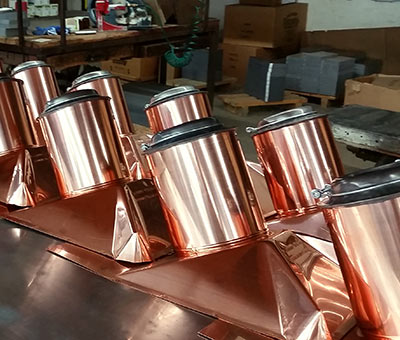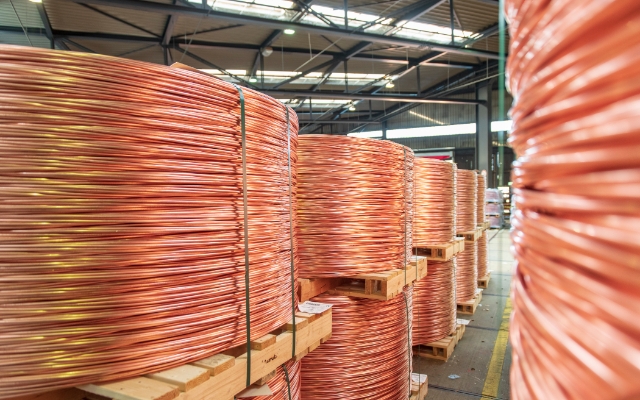Elevate Your Craftsmanship with High-Performance Copper Products for Artisans
Elevate Your Craftsmanship with High-Performance Copper Products for Artisans
Blog Article
Exactly How Copper Products Contribute to Sustainable Practices in Various Markets
Copper items are increasingly acknowledged for their substantial payments to sustainable techniques throughout multiple fields, driven by their inherent homes such as performance, recyclability, and sturdiness. In renewable resource systems, for example, copper improves the functionality of solar and wind innovations, while its application in building and construction decreases waste through longevity. The material's antimicrobial qualities supply appealing benefits in healthcare settings. As sectors look for to take on more lasting practices, the function of copper can verify crucial in achieving environmental objectives. What ramifications might this have for future innovations in sustainability?
Copper in Renewable Resource
Copper plays a critical duty in the improvement of renewable resource modern technologies, offering as an important conductor in numerous applications. Its extraordinary electric conductivity and resistance to rust make it an excellent product for electric wiring, which is crucial in photovoltaic panels, wind generators, and power storage systems. In solar photovoltaic or pv systems, copper is made use of in the affiliations and wiring, making it possible for reliable power conversion from sunshine to electrical power.
In wind power, copper is essential to the generators and transformers that convert kinetic power right into electrical power, making sure ideal performance and reliability. The need for electrical automobiles (EVs) is boosting, with copper being a key part in batteries, electric motors, and charging facilities. The shift to EVs substantially improves the demand for copper, as these automobiles commonly make use of four times extra copper than traditional inner burning engine lorries.
As the world seeks to mitigate climate change and transition to sustainable power resources, copper's function comes to be progressively vital. The material not only improves the efficiency and durability of renewable resource systems but likewise sustains the wider objective of reducing greenhouse gas discharges and advertising a sustainable future.
Eco-Friendly Construction Products
Recently, there has actually been a noteworthy change towards the adoption of eco-friendly building materials in action to growing ecological worries. This modification is inspired by the requirement for lasting options that minimize environmental footprints while preserving structural integrity and visual appeal.
Copper, understood for its resilience and recyclability, has actually arised as a principal in this sector. It can be made use of in roof covering, pipes, and electrical systems, contributing to energy performance and lowering waste. Copper's long life implies fewer replacements gradually, further improving its sustainability profile.
Furthermore, materials such as bamboo, reclaimed wood, and recycled steel are acquiring popularity. These alternatives not just supply decreased environmental effect yet also advertise source preservation. As developing codes significantly emphasize sustainability, engineers and contractors are integrating these products right into their projects, promoting development in layout.
The boosting adoption of environmentally friendly building and construction materials shows a more comprehensive commitment to sustainability in the constructed environment. By prioritizing these materials, the building sector can substantially decrease its carbon impact, line up with regulatory standards, and support a healthier ecosystem for future generations. This trend notes a crucial step in the direction of a more sustainable future in building.
Copper's Function in Health care
Recent studies have highlighted the significant duty of copper in medical care setups, specifically because of its antimicrobial properties. Copper surfaces have been revealed to minimize the existence of microorganisms, including bacteria and infections, by as much as 99.9% within a short period. This amazing effectiveness makes copper an important product for high-touch surface areas in medical facilities, such as doorknobs, bed rails, and IV poles, therefore contributing to improved infection control procedures.
Along with its straight antimicrobial impacts, copper additionally contributes in the more comprehensive context of healthcare facility sustainability (Copper Products). By incorporating copper into clinical equipment and home furnishings, health care centers can lower the incidence of healthcare-associated infections (HAIs), which not just enhances patient outcomes but likewise lowers the prices connected with prolonged health center stays and added treatments
Additionally, copper's longevity and recyclability align with lasting methods, allowing for liable resource administration. As healthcare systems progressively prioritize both individual safety and ecological stewardship, the assimilation of copper items is becoming more common. This dual advantage highlights copper's important payment to a healthier, much safer, and more lasting healthcare environment.
Sustainability in Transportation

Moreover, copper's longevity and corrosion resistance add to the long life of transport infrastructure (Copper Products). In rail systems, for instance, copper components improve the integrity and efficiency of signaling and power systems, important for reducing hold-ups and energy usage. Furthermore, copper's function in renewable resource systems, such as solar you could look here and wind, sustains sustainable transport remedies by offering tidy power for electrical transit alternatives
Investments in copper innovation not only foster sustainability yet also stimulate financial development and work creation in eco-friendly markets. As sectors strive to meet stringent ecological laws, the application of useful site copper products in transportation emerges as a critical approach in achieving sustainability objectives and advertising a cleaner, extra efficient future.
Copper and Round Economic Climate
As the world increasingly accepts sustainability, the role of copper in the round economic climate becomes ever more considerable. Copper's inherent properties-- such as its sturdiness, conductivity, and recyclability-- position it as a crucial material in a resource-efficient economic situation. The circular economic climate intends to reduce waste and maximize resource usage via recycling and reusing materials, and copper excels in this respect.
The steel can be recycled indefinitely without loss of top quality, making it an ideal candidate for sustainable practices across numerous markets, including building, electronic devices, and renewable resource. By recouping and recycling copper from end-of-life items, industries can dramatically decrease the requirement for virgin materials, consequently lowering ecological influences linked with mining and processing.
In addition, the combination of copper right into circular economic climate structures not just conserves resources but also fosters technology. Companies that focus on copper reusing add to a much more lasting supply chain, boosting their competition while lining up with governing needs and customer preferences for environmentally responsible products.
Final Thought
Finally, copper products substantially add to sustainable practices throughout numerous sectors. Their important role in enhancing renewable resource modern technologies, promoting environment-friendly construction materials, sustaining infection control in health care, assisting in lasting transportation, and embodying the principles of a round economic climate underscores the versatility and value of copper. By incorporating copper right into various applications, sectors can attain greater performance, minimize ecological effect, and straighten with worldwide sustainability objectives, eventually promoting a more lasting future.

Copper's exceptional conductivity makes it a recommended material in electrical automobile (EV) systems, boosting energy effectiveness and efficiency. In addition, copper's function in renewable energy systems, such as solar and wind, supports sustainable transportation remedies by giving tidy energy for electrical transportation choices.
Their vital duty in enhancing renewable energy innovations, advertising environmentally friendly construction materials, sustaining infection control in medical care, helping with sustainable transportation, and personifying the concepts of a circular economic climate underscores the adaptability and value of copper.
Report this page